Get ironclad security and privacy for your phone with Avast One
- Security
- Privacy
- Performance
There’s no such thing as too much storage space. But the more space we have, the more stuff we tend to keep — until we get the “Storage Almost Full” message, even on iPhones or iPads with lots of space. Keep reading to learn how to clean storage on your iPhone and iPad. Then, install Avast One to help keep your iPhone storage safe and your phone running smoothly.

You can check your iPhone storage by going to Settings > General > iPhone Storage. When your storage is filling up, you’ll get a “storage almost full” warning message. iPhones can run out of space if you save too many media files or apps, or have lots of unnecessary junk files.

This Article Contains:
It took just four months for me to get a storage warning on my new iPhone, after saving several videos, downloading some Spotify playlists and YouTube clips, and installing a few games. In this article, I’ll walk you through the steps so you know how to clear system data on iPhone, just like I did.
Before you start cleaning, remember that clearing storage on an iPhone and removing junk files is only part of the process of ensuring a phone stays healthy and fast. For comprehensive phone hygiene, install Avast One, a totally free mobile security and privacy app that encrypts your photos and protects your phone from unsafe websites and personal data leaks.
You can clean your iPhone browser cache in your device settings. Clearing your iPhone browsing data is the first step in cleaning up your iPhone. Browser cache in Safari (like any web browser) should be cleared regularly to ensure that junk doesn’t accumulate unnecessarily.
As you surf the web, Safari stores a lot of information on your device. Most of it can be cleared, such as cookies, images, and browser history data. Some data is used regularly (like bookmarks), but much of it is temporary data (called a cache). Cache data can be useful for future website visits, because it includes recent search history and saves mobile data usage.
But, caches are meant to be temporary — and too often, they’re never cleaned up. That clutters up your device and wastes a ton of storage space.
Here’s how to clear the cache on your iPhone:
Open the Settings app on your iPhone and choose Safari.
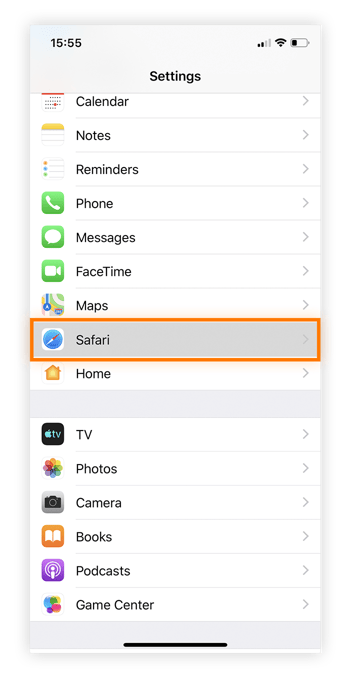
Scroll down and tap Clear History and Website Data.
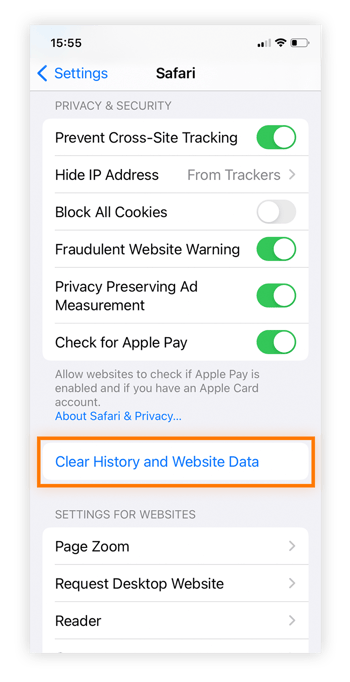
Confirm by tapping Clear History and Data.
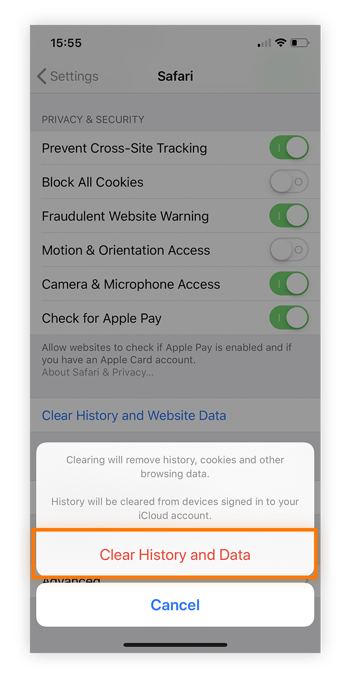
To see how much storage space on your iPhone is taken up by temporary files, tap Advanced and Website Data. I visited one site and opened one article, and the result was three dozen entries, amounting to 7.8 MB of phone storage. That shows you how many junk files get left behind in your iPhone cache after visiting just one site.

Most apps aren’t perfectly optimized. Many mobile apps waste storage space and clutter system data — due to both the size of the mobile app (e.g., Facebook) and the data it stores locally. Stored system data is sometimes hidden deep within an app — you might not even be aware that it’s being collected.
The following sections show you how to delete documents and data on your iPhone:
Spotify Premium lets you save songs and playlists offline. If you’re like me, you often just flip the Download switch without realizing you’re about to download 10 GB of music.

Here are steps to help you find the largest data hogs hidden within your apps, so you can remove that system data to clear storage on your iPhone.
Go to the Settings app on your iPhone. Tap General, then navigate to iPhone Storage. This screen shows an overview of what’s taking up your iPhone’s space:
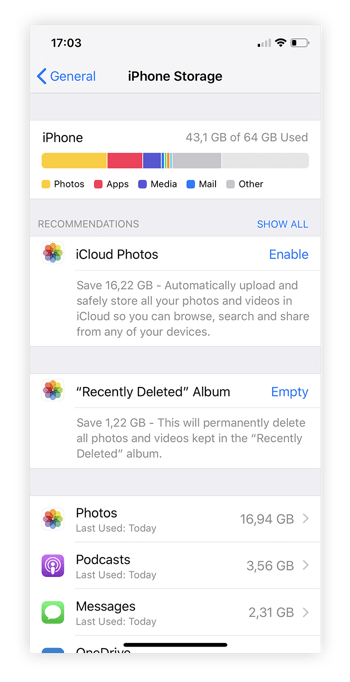
Get more details by tapping an app and checking your options:
Use Offload App to delete an app and keep its files. Offloading an app is useful if you don’t use an app often, the app is large, and if its stored data is small. For example, you may use a company app to process business expenses only once a quarter — it’s best to keep the data, but re-download the app only when you need it.
If an app has been on your phone for a while but you don’t use it, delete the app. This is especially useful if the app is huge and you can’t find a solution to clearing the system data from your iPhone. Deleting and reinstalling the app gets rid of its cache files automatically, but make sure you don’t delete any important files first.
Another advantage to deleting old apps is that it improves your iPhone’s performance. You’ve also got options on the iPhone Storage screen for how to delete documents and data on your iPhone without deleting the app. Here’s how:
Group chats are a curse for your iPhone’s storage. Every video, picture, and attachment you send is stored on your phone — until you manually delete it. That doesn’t just take up a ton of storage on your iPhone (especially if your friends love to share photos) — it’s also a privacy concern.
To remove old iMessages, go to the list of apps shown on the iPhone Storage screen and tap Messages. Here, you can get rid of large attachments, such as videos or photographs. In my case, that’s 2.31 GB of cleared iPhone storage.

Or, you can go into the iMessage app directly and delete individual conversations.
You can go through all your photo albums and delete the ones you don’t need, but all that tapping and deleting could take days. To delete old and unneeded photos more easily (and save lots of time), open Settings > General > iPhone Storage and navigate to the Photos app.
From here, you can delete the “Recently Deleted” Album by tapping Empty. You can also open Review Personal Videos, which shows a list of the largest videos that, when deleted, will help clear some of your iPhone storage.

Check these lists carefully so you don’t get rid of important photos. You can also upload photos to iCloud. If you opt for Apple’s paid plan, it offers as much as 50 GB of storage instead of the free 5 GB. Saving your photos to iCloud helps you free up local storage on your iPhone, while keeping all your photos conveniently accessible in the cloud.
For those photos you want to keep out of the cloud and safely on your iPhone, install Avast One. Our dedicated iPhone security and privacy app includes an encrypted photo vault, only accessible with your fingerprint, face scan, or passcode.
I subscribe to about 30 podcasts. Many of them have weekly, sometimes daily, episodes. That’s far more content than I can consume regularly.
The iPhone Podcast app automatically downloads new episodes and keeps them until I finish listening. Its settings also let you control how many old episodes to store. But even if you’re an avid listener, it’s unlikely you’ll listen to all those saved episodes.
To browse your saved podcast episodes and remove them to free up system data, open your Podcast app and tap the podcast you want to remove data for. Tap and hold the episode you want to delete, then select Remove Downloads.
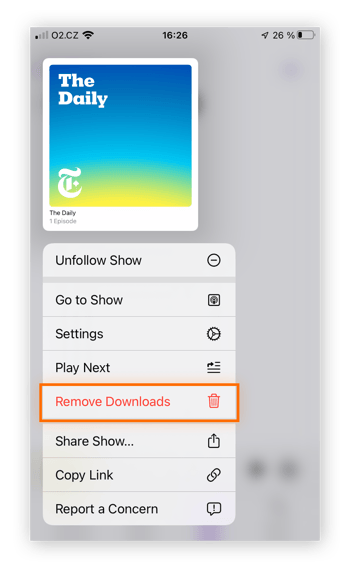
This can clear a ton of space on your iPhone. In my case, it freed up a whopping 3 GB.
Note that deleting a podcast episode doesn’t mean you’re unsubscribing — new episodes will still be downloaded automatically.
The iPhone Storage list categorizes all items stored on your device. Any junk files or cache that your phone doesn’t know how to index end up in Other storage. For example, when you download music, it’s automatically categorized as Media. But, if you’d rather stream your music, your iPhone collects the cache and keeps it in Other storage.
To remove junk files saved in Other storage, go to Settings > General > iPhone Storage. A graph will appear at the top of the screen showing you how much space your Other storage is taking up. Clearing app data for individual apps should help clean junk files from your iPhone.
If you’re a loyal Apple user, you can also clear your Other storage on Mac to keep both devices fresh and clean. Take a deeper dive into our guide to cleaning up your Mac here.
An easy way to quickly clear storage space is to clean up junk files on your iPhone. These files are stored as logs, cache, and cookies in individual apps. Over time, this “junk” can slow down your iPhone and clog its memory. Clean up junk files on your iPhone by opening Settings > General > iPhone Storage. Open individual apps to delete downloads and data files.
You can also uninstall and reinstall apps to clear your iPhone’s junk files and update your apps at the same time.
I tend to forget about video players, which also hog storage space on iPhones. For example, I subscribe to YouTube Premium, which lets me download YouTube clips to my iPhone. I also subscribe to VLC Player, which I use to store and play videos.
Unfortunately, the iPhone Storage list doesn’t help you identify specific videos consuming storage, and it doesn’t let you delete individual files on your iPhone.
To delete video files on your iPhone, open the YouTube app, go to Library > Downloads, then delete the offline videos by tapping Delete from downloads.

I clean my iPhone every few months — maybe more if I’m in immediate need of a cleanup. (For example, before traveling to Japan recently, I had to clear space on my iPad to download more videos to tide me over during the trip.)
But sometimes, you may need a complete factory reset. If you’re giving your old iPhone to a friend, the issue is less about getting rid of personal data, and more about making sure your iPhone is as clean as the day you bought it. When you perform a factory reset, you’ll wipe not just leftover files from your apps, but from iOS itself.
Be careful before you factory reset your iPhone — don’t make this choice lightly.
Before you do a factory reset, ensure that all your files are backed up and important settings are stored (or written down). Also, make sure all your passwords are backed up. When you’re done, be sure to protect your phone with an iOS security app.
To wipe your phone clean, go to Settings > General, then scroll down to Reset. Select Erase All Content and Settings. If you use iCloud, wait until all important settings are uploaded, then confirm.
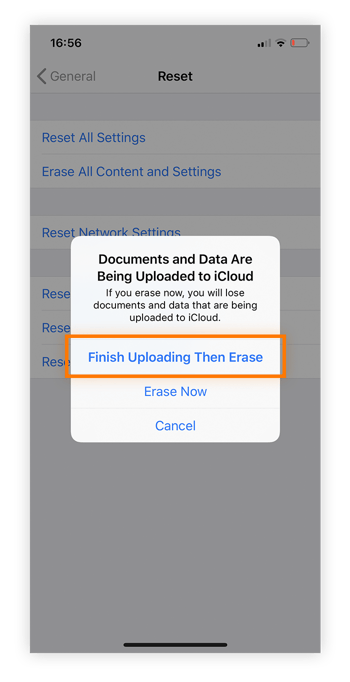
The process can take a while. But in the end, you’ll have a fresh and clean iPhone.
But now that you know how to clear your iPhone of unnecessary downloads, data, and junk, you won’t need to perform a factory reset each time you want to clear some storage space.
Make sure to check out our guides to cleaning up your Windows PC and keeping your Android clean, too.
Now that you’ve cleaned your iPhone from top to bottom, you should fortify its security and privacy, too. Yes, even iPhones can be impacted by cybersecurity threats.
Avast One for iOS keeps you safe every time you go online and download content, with innovative tools — like encrypted folders for your photos and a specialized Web Shield — designed especially for your iPhone and iPad. Install it free today.
Install free Avast One to get powerful protection against dangerous websites, data breaches, other privacy and security threats to your iPhone.
Install free Avast One to get powerful protection against dangerous websites, data breaches, other privacy and security threats to your iPhone.
Install free Avast One to get powerful protection against dangerous websites, data breaches, other privacy and security threats to your iPhone.
Install free Avast One to get powerful protection against dangerous websites, data breaches, other privacy and security threats to your iPhone.
Get ironclad security and privacy for your phone with Avast One
Get ironclad security and privacy for your iPhone with Avast One